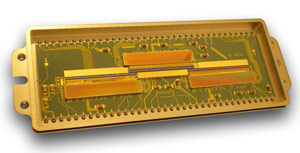- News
6 May 2013
Xenics’ new Xlin-1.7-3000 InGaAs SWIR detector launched aboard Proba-V satellite
Xenics nv of Leuven, Belgium - a manufacturer of infrared detectors, cameras and customized IR imaging solutions covering the spectrum from long-wavelength infrared (LWIR) to the visible (0.4–14μm) – says that on 3 May three of its new Xlin-1.7-3000 SWIR InGaAs detectors were launched from Kourou, French Guyana aboard the European Space Agency (ESA) satellite Proba-V (on the new ESA VEGA launcher) in order to map crop and vegetation patterns across the earth. Besides delivering highest resolution, the new line-scan detector offers high line rates and low noise.
Introduced at SPIE Defense, Security and Sensing show (DSS 2013) in Baltimore, MD, USA (29 April - 2 May), the Xlin-1.7-3000 is an uncooled short-wave infrared (SWIR) indium gallium arsenide (InGaAs) line-scan detector that offers over 3000 pixels of resolution (claimed to be the best specification of any such device on the market). Xenics says that, with high sensitivity in the SWIR range (0.9-1.7μm), the Xlin-1.7-3000 is suited to the Proba-V (vegetation) satellite mission, which orbits at an altitude of 880km to reveal detailed long-term information on the changing crop and vegetation patterns of the planet and other vital parameters for preserving the biosphere.
 Picture: Xenics’ new Xlin-1.7-3000 SWIR InGaAs detector.
Picture: Xenics’ new Xlin-1.7-3000 SWIR InGaAs detector.
The Xlin-1.7-3000 is qualified for space missions with 10krad of ionizing radiation while maintaining its specified performance. A full qualification campaign was performed, as prescribed by ESA, covering harsh environmental, radiation and life-test conditions. Aboard Proba-V, the detectors are delivering earth environmental information in the SWIR range over a swath of 2200km with a center resolution of just 100m.
The Xlin-1.7-3000 consists of three individual InGaAs sub-arrays of 1024 square pixels (25μm x 25μm) each. They are mechanically butted on a gold-coated boat and mounted on an alumina substrate, together with three individual readout-ICs (ROIC). The overlap of 20 pixels enables perfect stitching of three individual images to a continuous line of 3020 pixels over a length of 75.5mm. The detector is assembled in a custom hermetically sealed 72-pin package with anti-reflective coated window. It is optionally also available in an open package.
With a fill factor of 100%, high quantum efficiency of 75% and adjustable sensitivity, the uncooled InGaAs detector operates at very low illumination levels. The three individual readout-ICs are manufactured in 0.35μm CMOS technology and CTIA topology, resulting in a high radiation tolerance for space applications. They allow a maximum pixel rate of 12.5MHz, yielding a minimum line time of 100μs, or an output frequency of up to 10kHz.
The ROICs are designed for maximum flexibility, says Xenics. Aboard Proba-V, many of their operational parameters can be controlled in real time to adapt the detectors’ characteristics to specific observation conditions and get the best value in terms of line period and integration times (1μs to 1s). Variable gain setting enables the operator to set pixel well depth, resulting in a wide span of sensitivity values beginning at just 60ke- (dynamic range 60:1), to a very high dynamic range of 3200:1 (pixel well depth 10Me-). The Proba-V mission can hence be adapted to various conditions in terms of illumination (night/day), objects of interest (ice/desert/vegetation/water) and global or detailed imaging.



